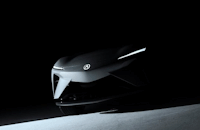Cadillac back-up open A review of 2026 owner’s manuals found one update for our Cadillac back-up open page, which is finished. A back-up entry option is made necessary in the event that the key fob battery has died, The new Vistiq and Optiq electric vehicles (EVs) follow the same path as the original Lyriq EV: …
Tag: EV
Permanent link to this article: https://dashboardsymbols.com/2025/08/new-jump-start-video-dropped-on-our-youtube-channel/
Permanent link to this article: https://dashboardsymbols.com/2025/08/cadillac-back-up-open-page-updated-for-2026/
New Acura EV prototype to be unveiled during Monterey Car Week
Acura EV prototype We recently noted that neither Honda or Acura had progressed their electric vehicle (EV) models and we speculated that they may be readying their own builds. Sure enough, an announcement came through on August 8th that an Acura EV prototype would be debuted globally at the Monterey Car Week. The show, which …
Permanent link to this article: https://dashboardsymbols.com/2025/08/new-acura-ev-prototype-to-be-unveiled-during-monterey-car-week/
EV manufacturers continue to struggle with the legacy ICE grille
Legacy ICE grille When I saw it, I had to laugh. InsideEVs did a story on the new Mercedes-Benz GLC electric crossover essentially sporting a legacy ICE grille. The story noted that the car will get the “face of the future.” And that face is clearly a massive legacy ICE grille that only proves that EV …
Permanent link to this article: https://dashboardsymbols.com/2025/08/ev-manufacturers-continue-to-struggle-with-the-legacy-ice-grille/
Acura symbols review offers a surprise
Acura symbols A review of Acura symbols for 2026 found a single new systems requiring an addition. That was a Dynamic Lift Mode Indicator, which we posted yesterday. Make no mistake — adding but a single symbol for a model year is very, very unusual. We generally add anywhere from three to as many as …
Permanent link to this article: https://dashboardsymbols.com/2025/08/acura-symbols-review-offers-a-surprise/
What will come of old EV batteries? Think energy storage…
Energy storage From Inside Climate News, 500 “pre-owned” electric vehicle (EV) batteries are soon to provide energy storage for the Texas electric grid. B2U Storage Solutions out of Lancaster, California is heading up the project. The company has plans for three more facilities of similar size, also in Texas. B2U began life building industrial scale …
Permanent link to this article: https://dashboardsymbols.com/2025/08/what-will-come-of-old-ev-batteries-think-energy-storage/
Even cleaner cars: EVs reduce brake dust
Brake dust Just when we thought we knew everything there is to know about regenerative braking, we saw this from InsideEVs. There’s a whole new way that an EV helps improve the air we breath. Brake dust! Or more to the point, the lack of it. The use of regenerative braking reduces brake wear and …
Permanent link to this article: https://dashboardsymbols.com/2025/07/even-cleaner-cars-evs-reduce-brake-dust/



New EV jump start video dropped on our YouTube Channel
Jump start video We just added a new jump start video to our YouTube channel with help for Chevrolet EV drivers with dead start batteries. These and all electric vehicles (EVs) use a 12-volt battery to actually start the car, much like a 12-volt battery is used to start an internal combustion engine vehicle. And …
Continue reading